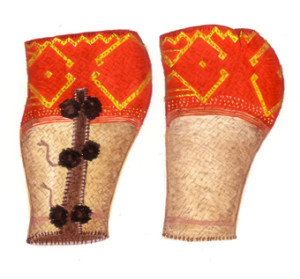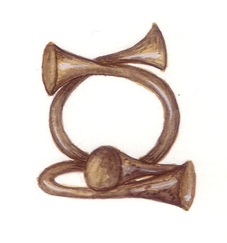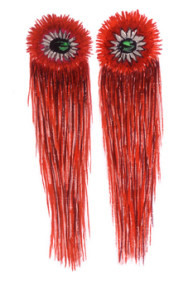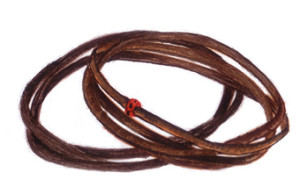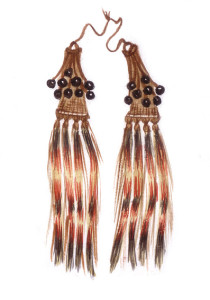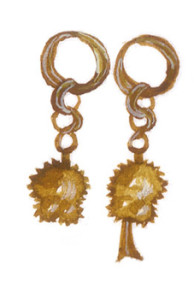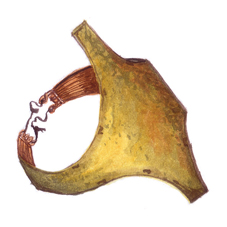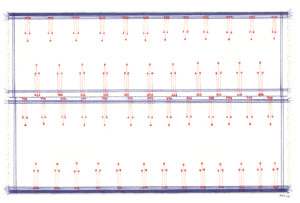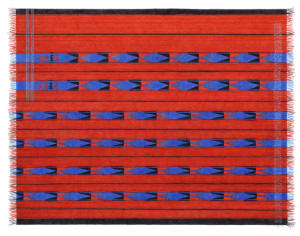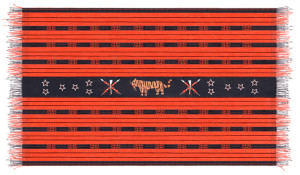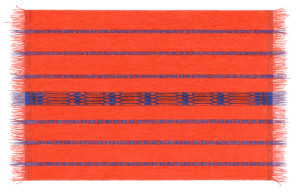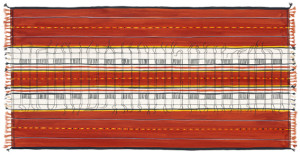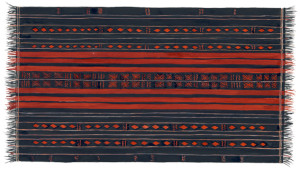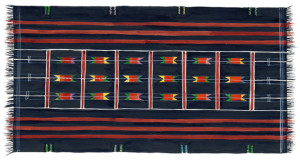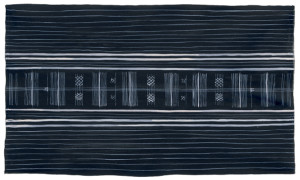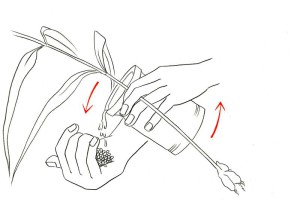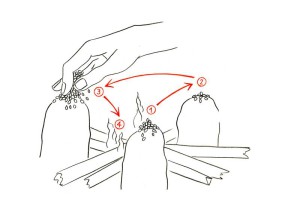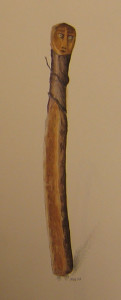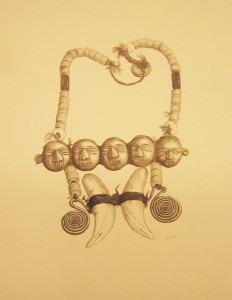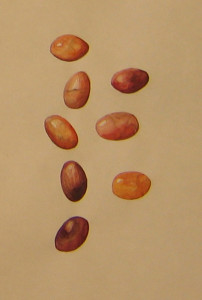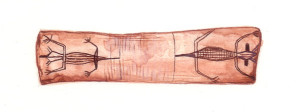 “Scientific illustrations are not frills or summaries; they are foci for modes of thought” (Stephen Jay Gould 1987)
“Scientific illustrations are not frills or summaries; they are foci for modes of thought” (Stephen Jay Gould 1987)
The visual representation of ethnographic data has been discussed in visual anthropology mainly focussing on the media of photography and film (see for example Heider 1976, Edwards 1992, Taylor 1994, Banks 2001, Grimshaw 2001, El Guindi 2004). One of the oldest medium however, the ethnographic drawing, has largely gone forgotten – notwithstanding the importance it once had in the 19th century and before. Even recent approaches to visual science or the “Bildwissenschaften” do not pay much attention to it (see for example Postma & Crawford 2006, Pink, 2006, 2007, Belting 2001, Majetschak 2005, Schulz 2005). In his essay “Drawing or Photograph: Questions on ethnographic illustration” Oppitz asks (2001:118): “Is the ethnographic drawing an outdated mode? If so, which constitute adequate contemporary forms of documentary expression? This trenchant question has (to my knowledge) never been posed directly, but it has been answered silently again and again in the course of the last century – by publishing practice.” There are only very few approaches having reflected about the qualities, the advantages – and disadvantages – of drawing as a medium of ethnographic visualisation vis-à-vis other visual media. Reflections about the medium of drawing and its kindred manual picturing techniques in the context of a larger approach to visual science have only started to come up in the last few years. An exemplary history of the transformation from research drawing to ethnographic photography for instance has recently been published by Kümin on the example of Brazil (Oppitz 2001, Afonso 2004, Nippa 2001, Kümin 2007).
While working on my dissertation about Naga textiles, I experienced that drawing ethnographic objects helps to get a deep understanding of the matter one is studying. During my research, drawing textiles became one of the most important methodical approaches to the topic. To reflect about this medium of representation in theory and in praxis is therefore currently of major concern to me. I found that drawing has the advantage that you can formulate an image much more precise than when doing a photograph. When consciously composing a drawing you have to be clear about what you want to show, and the visual representation becomes a statement in your line of argumentation; just like a sentence is a statement in you textual argumentation. This is the way in which I understand the motto of this page: To use scientific illustrations as modes of thoughts means to choose or produce those techniques of visual representation in a given context, that fulfil the purpose of the argumentation most accurately. And in anthropology it has gone forgotten that the technique of drawing is often very helpful in this respect.
The initial incentive to start drawing ethnographic objects came through the Australian architect and artist Robert Powell. He was invited by Michael Oppitz to give practical teachings for interested students of anthropology at the Völkerkundemuseum der Universität Zürich in 2002 and 2007. His style of drawing, especially of decontextualising the object, has strongly influenced my own approach. When thinking about Powell’s drawings, Oppitz found them highly suitable as “emblematic markers”. They became “vessels of symbolic signification. (…) The material presence of the objects is intensified by their decontextualisation. (…) Bob’s (Robert Powell’s) drawings are extremely selective, radically omitting anything secondary. They stand alone on the sheet, undisturbed, undistracted, demanding an exclusive and solitary dialogue with the observer, on the isolated ethnographic subject they capture” (Oppitz 2001:99). For an impression of his work see Oppitz 2001.
Drawings
The following miniature drawings of Naga material culture I made in watercolour in 2007. Some of the drawings measure not more than 2-3 cm. Their purpose was to have small representations of Naga objects which are all in the same scale. I used these miniatures as models to arrange the show cases for an exhibition in Zürich (Naga – Schmuck und Asche, 2008). With the help of these drawings, of which 40 are in colour and dozens more in black ink, it was possible to precisely plan the layout of the exhibition on paper.
The following four examples of colour pencils drawings show textiles of the Ao Naga. The top two are women’s skirts, the bottom two are men’s shawls, drawn on A4 paper. The purpose of these drawings is to have a visual representation of Ao textiles that are all made in the same style and thus all speak the same visual language. For the observer there is no need to translate the visual media when comparing the pictures. In a drawing it is possible to simultaneously depict the total model of the cloth and the many small details of the design. With photography this is much more difficult, if not impossible, without having to make several pictures of the same object. The four images are chosen from the more than 60 drawings of Ao textiles that are published in my dissertation thesis “Naga Textiles” (Wettstein 2014). (Click on the image to enlarge.)
The next four drawings of Naga textiles are done with watercolour on A5 paper or smaller. Like with the colour pencil drawings above their purpose as well is to create visual representations of textiles that all have the same drawing style, so that in a comparison the visual medium does not distract from the actual topic: the design of the textiles. They are taken from among the more than 150 textile drawings on a ‘design chart’ that shows the morphological groups of textile designs among the Nagas. The ‘design chart’ is attached as a 100×140 cm poster to my book on “Naga Textiles” (Wettstein 2014). (Click on the image to enlarge.)
The following three drawings are a selection taken from a range of drawings I made for a visual partitura of a a ritual offering to the ancestors among the Dumi Rai of eastern Nepal. The partitura shows the parallel happenings of the movements, recited text, and musical aspects of the ritual (fothcoming publication Wettstein, von Stockhausen, and C.B. Rai).
The following images are a collection of watercolours and drawings that I made at the very beginning of my experiences in ethnographic drawing. They show a beater of a shaman’s drum, a Naga head-hunters necklace and a study for carnelian stone beads. (Click on image to enlarge)
Publications with drawings by Marion Wettstein:
- Rai, Nirpa, Tejmaya Rai, Rajendra Rai, Jagat Bahadur Rai, Sahajit Rai, and Mahendra Rai (eds.). 2011 (BS 2068). Dumi-Nepali-English Dictionary. Baksila: Dumi Kirat Rai Fansikim. [Ink pen drawings of Dumi Rai ritual objects].
- Stockhausen, von, Alban. 2007. Guiding the Way: Death Rituals of the Dumi Rai of Eastern Nepal. Master-Thesis at the Philosophical Faculty of the University of Zürich. [Ink pen drawings of Dumi Rai ritual objects and settings].
- Wettstein, Marion. 2014 Naga Textiles: Design, Technique, Meaning and Effect of a Local Craft Tradition in Northeast India. Stuttgart: Arnoldsche Art Publishers. [Colour pencil drawings and watercolours of Naga Textiles, ink pen drawings of textile techniques and objects for textile production].
–> see bonus material / –> leaf through the book and order at publisher’s page / –> order at amazon.de - Wettstein, Marion. 2008 “Defeated Warriors, Successful Weavers: Or how Men’s Dress Reveals Shifts of Male Identity among the Ao Nagas”. In: Michael Oppitz, Thomas Kaiser and Alban von Stockhausen, and Marion Wettstein (eds.), Naga Identities: Changing Cultures in the Northeast of India. Gent: Snoeck. Pp. 129-146. [Colour pencil drawings of Ao Naga men”s shawls].
–> download pdf “Defeated Warriors, Successful Weavers”: Wettstein2008DefeatedWarriorsSuccessfulWeavers - Wettstein, Marion. 2008 “Der Ursprung des Webens”. In: W. Marschall, P. von Wyss-Giacosa & A. Isler (Hrsg.), Genauigkeit: Schöne Wissenschaft. Bern und Sulgen: Benteli. S. 237-239. [Watercolor of an Angami Naga woman’s skirt].
- Wettstein, Marion, Alban von Stockhausen and Chatur Bhakta Rai. 2019. “Nuja: Text, Melody, and Movement of a ‘New Grain’ Ritual Performance among the Dumi Rai of Eastern Nepal” In: M. Gaenszle (ed.), Ritual Speech in the Himalayas: Oral Texts and their Contexts. (Harvard Oriental Series). Cambridge, MA: Harvard University Press. Pp. 71-104. [Partitura with inkpen drawings of ritual bodily movements.]
References cited:
- Afonso, Ana Isabel (Illustrations Manuel João Ramos). 2004. “New Graphics for Old Stories: Representation of Local Memories through Drawings.” In: Sarah Pink, László Kürti & Ana Isabel Afonso (eds), Working Images: Visual Research and Representation in Ethnography. New York: Routledge. Pp. 72-89.
- Banks, Marcus. 2001. Visual Methods in Social Research. London: SAGE.
- Belting, Hans. 2005. “Nieder mit den Bildern. Alle Macht den Zeichen. Aus der Vorgeschichte der Semiotik”. In: Stefan Majetschak (Hrsg.), Bild-Zeichen: Perspektiven einer Wissenschaft vom Bild. München: Wilhelm Fink Verlag. S. 31-47.
- Edwards, Elizabeth (ed.). 1992. Anthropology & Photography 1860 -1920. New Haven and London: Yale University Press.
- Gould, Stephen Jay. 1987. “This View of Life: Life’s Little Jokes. In: Natural History 96(April 1987): 16
- Guindi, El, Fadwa. Â 2004. Visual Anthropology: Essential Method and Theory. Walnut Creek: Rowman Altamira.
- Heider, Karl G. 1976. Ethnographic Film. Austin: University of Texas Press.
- Kümin, Beatrice. 2007. Expedition Brasilien. Von der Forschungszeichnung zur ethnografischen Fotografie. Zürich: Benteli Verlag.
- Majetschak, Stefan. (Hrsg.). 2005. Bild-Zeichen: Perspektiven einer Wissenschaft vom Bild. München: Wilhelm Fink Verlag.
- Nippa, Annegret. 2001. “Die Schwäche der Zeichnung ist ihre Stärke: Zeichnen mit Stift, Farbe oder Licht”. In: Verwandlungen durch Licht. Fotografieren in Museen & Archiven & Bibliotheken, Esslingen 2001 (Rundbrief Fotografie, Sonderheft 6), S. 41-52.
- Oppitz, Michael (ed.). 2001. Robert Powell. Himalayan Drawings. Zürich: Völkerkundemuseum der Universität Zürich.
- Pink, Sarah. 2006. The Future of Visual Anthropology: Engaging the Senses. Oxon, New York: Taylor & Francis.
- Pink, Sarah. 2007. Doing Visual Ethnography: Images, Media and Representation in Research. London (etc.): SAGE.
- Postma, Metje & Peter Ian Crawford. 2006. Reflecting Visual Ethnography: Using the Camera in Anthropological Research. Leiden: CNWS Publications.
- Schulz, Martin. 2005. Ordnungen der Bilder: eine Einführung in die Bildwissenschaft. Wilhelm Fink Verlag.
- Taylor, Lucien. 1994. Visualizing Theory: Selected Essays from V.A.R., 1990-1994. New York: Routledge.
- Wettstein, Marion. 2014 (Oct.). Naga Textiles: Design, Technique, Meaning and Effect of a Local Craft Tradition in Northeast India. Stuttgart: Arnoldsche Art Publishers. (Dissertation Thesis)
- Wettstein, Marion, Alban von Stockhausen and Chatur Bhakta Rai. (forthcoming). “Nuja: Text, Melody, and Movement of a ‘New Grain’ Ritual Performance among the Dumi Rai of Eastern Nepal”, in an edited volume on Ritual Speech by Martin Gaenszle.

